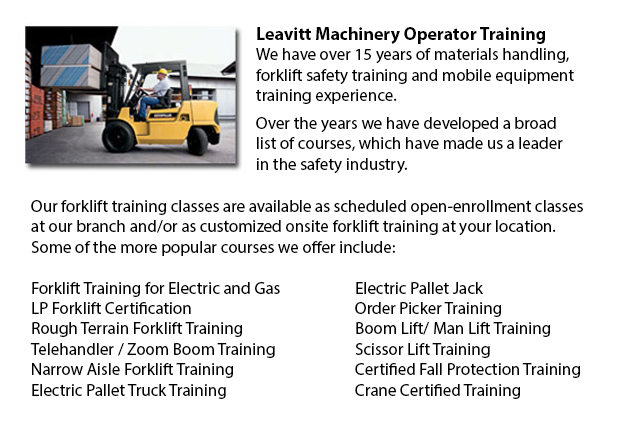
Forklift Training Schools Whitby - Reasons Why People Who Utilize A Forklift Should Take Any Of Our Forklift Training Schools
If you are searching for a job as an operator of a forklift, our regulatory-compliant forklift training Schools provide excellent instruction in numerous types and styles of lift trucks, lessons on pre-shift check, fuel types and handling of fuels, and safe operation of a forklift. Hands-on, practical training helps individuals participating in acquiring essential operational skills. Program content includes existing rules governing the use of forklifts. Our proven forklift Schools are designed to provide training on these types of trucks: narrow isle forklift, counterbalanced forklift and powered pallet truck.
Do not lower or raise the fork whilst the forklift is traveling. A load should not extend above the backrest because of the possibility of the load sliding back toward the operator. Check for overhead obstacles and ensure there is adequate clearance prior to lifting a load. Stay away from overhead power lines. When the load is raised straight up, tilt it slightly back.
While the load is raised the lift truck would be less steady. Make sure that no pedestrians cross under the elevated fork. The operator must not leave the lift truck while the load is lifted.
The forks should be level when handling pallets, and high enough to extend all the way into and underneath the load. The fork's width must provide equal distribution of weight.
Before unloading or loading the truck, chock the wheels and set the brakes. Floors need to be strong enough to support the weight of the forklift and the load combined. Fixed jacks could be installed to support a semi-trailer which is not attached to a tractor. The entrance door height should clear the height of the forklift by at least 5 cm. Mark edges of rail cars, ramps or docks and avoid them.
-
Wheel Loader Operator Training Whitby
Wheel Loader Operator Training Whitby - To be able to lift considerable loads, industrial cranes use levers and pulleys. In the past, Roman people used cranes to be able to erect large monuments making the origin of these equipment at least two thous... More -
Aerial Lift / Boom Lift / Man Lift / Scissor Lift Training in Whitby
Scissor lifts are lift truck tables which lift up materials and people and supplies vertically. They are normally utilized in commercial, industrial and construction environments. A common use of scissor lifts is for lifting or lowering construction... More -
Manlift Operator Training Whitby
Manlift Operator Training Whitby - A specialized kind of hydraulic platform is called an aerial lift or a man lift. It is intended to lift an individual vertically up and down and thus, is likewise known as a vertical personnel lift. This machinery i... More -
Aerial Lift Ticket Whitby
Aerial Lift Ticket Whitby - A boom truck is frequently recognized by the cable and telephone business vans that have the extended arm folded over their roofs. Commonly, a bucket-like apparatus sits at the extension of extendable arms. Often known as... More -
Crane Training Whitby
Crane Training Whitby - Overhead cranes are otherwise known as bridge cranes. They are a kind of crane which has a line and hook mechanism which runs along a horizontal beam which runs along two widely separated rails. Numerous overhead cranes could... More -
Forklift Certification Schools Whitby
Forklift Certification Schools Whitby - Within North America, forklift certification is mandatory, making forklift training programs essential for both the company and their employees working as operators of forklifts. Forklift training focuses on he... More -
Crane Safety Training Whitby
Crane Safety Training Whitby - Companies and crane drivers need to be aware of the issues connected to crane safety. Legislation provides rules for the safe operation, inspection and maintenance of lifting machinery all around North America. Crane Sa... More -
Overhead Crane Certification Whitby
Overhead Crane Certification Whitby - The overhead crane certification course is a course that is designed to assist trainees, even if they have literacy or language restrictions. The program consists of a classroom theory part and a practical hands-... More

Forklift Training Whitby
TOLL FREE: 1-888-254-6157
Whitby, Ontario
forklifttrainingwhitby.com
Email Us
About Us


